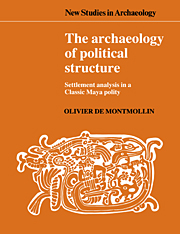Book contents
- Frontmatter
- Contents
- List of figures
- List of tables
- Preface
- 1 Studying ancient complex polities
- 2 Thinking about Maya political structure
- 3 The Rosario polity
- 4 Linking Maya politics and settlement
- 5 Centralization
- 6 Differentiation and integration
- 7 Political regimes and microcosms
- 8 Political stratification patterns
- 9 Mechanical versus organic solidarity
- 10 Segmenting versus non-segmenting organization
- 11 Archaeological study of Maya polities
- Notes
- References
- Index
4 - Linking Maya politics and settlement
Published online by Cambridge University Press: 29 March 2010
- Frontmatter
- Contents
- List of figures
- List of tables
- Preface
- 1 Studying ancient complex polities
- 2 Thinking about Maya political structure
- 3 The Rosario polity
- 4 Linking Maya politics and settlement
- 5 Centralization
- 6 Differentiation and integration
- 7 Political regimes and microcosms
- 8 Political stratification patterns
- 9 Mechanical versus organic solidarity
- 10 Segmenting versus non-segmenting organization
- 11 Archaeological study of Maya polities
- Notes
- References
- Index
Summary
Bridging arguments for ancient complex polities
Archaeological studies of ancient complex polities often rest on a base of weakly developed bridging arguments for linking theoretical concepts to data in the archaeological record (Chapter 1). Bridging arguments are indeed difficult to develop for such complex subject matter. Furthermore, devoting a lot of attention to them detracts from the time available for pondering what seem to be more fascinating great questions (Chapter 1) and substantive details associated with civilizations. However, there can be no doubt that building bridging arguments has a fascination of its own, requiring intricate problem solving and vigorous imagination on the part of the archaeologist (well exemplified in Binford's Palaeolithic studies- 1983a, 1983b).
In looking at bridging arguments and their uses it makes sense to distinguish “between theory treated methodologically as a means of investigating another theory and theory treated substantively as the theory to be investigated” (Bailey 1983: 177). From this perspective, constructing bridging arguments is a methodological means to an end. For example, alternate notions about politics (behavior) are related through bridging arguments to distinguishable settlement patterns (material culture). From a different perspective, the distinction between substantive and methodological theories begins to blur. What look like bridging arguments take on a more intrinsic theoretical interest. For example, an argument that links settlement-density patterns (seen in material culture) and sociopolitical patterns (behavior) becomes the central focus of theoretical interest (Fletcher 1981). This seems to be the trend in certain forms of ethnoarchaeology where material culture is the main archaeological subject matter (Hodder 1982) and the call is for theoretical work to develop generalizations about the role of material culture in creating political structure and organization.
- Type
- Chapter
- Information
- The Archaeology of Political StructureSettlement Analysis in a Classic Maya Polity, pp. 50 - 75Publisher: Cambridge University PressPrint publication year: 1989



